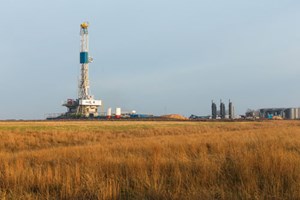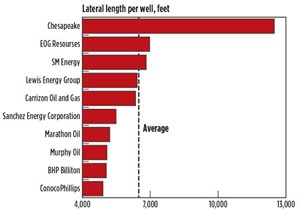Shaletech: Eagle Ford Shale
South Texas’ Eagle Ford has made its way back to the corner office, where key players are keeping one eye on service costs while driving aggressive drilling and completion programs aimed at arresting a nearly two-year decline in production.

Among the more badly bruised of the unconventional plays at the depths of the downturn, the Eagle Ford has rebounded sharply, at least over the first half of 2017. Even after a six-rig drop from the week of July 14 through the week of July 21, the year-over-year rig count remains well over double, while horizontal drilling permits issued in the first half of 2017 already surpass the total authorizations for all of last year. Completed well costs have dropped, in some cases, to below $4 million/well, pushing oil production ever closer to 1.4 million bpd, with natural gas following a similar track.
The heightened activity marks a dramatic turnaround for a play generally accepted as a stepchild of the hyperactive Permian basin—a characterization that ConocoPhillips, for one, strongly rebuts. “With all the pressure in other places like the Permian, the Eagle Ford has been a good place to operate with less pressure on inflation and better netbacks for the barrels that you’re sending out,” says Al Hirshberg, executive vice president of production, drilling and projects.
Putting action to words, ConocoPhillips has directed five rigs to the Eagle Ford in 2017, compared to three active rigs in all of its U.S. onshore assets at this time last year. Justifying the increased spending, first-quarter production from its 213,000-net-acre position averaged 133,000 bpd, accounting for 60% of the average 221,000 bpd delivered from its entire Lower 48 unconventional portfolio. “It’s pretty clear that the next place we would add a rig would be the Eagle Ford,” he said.
Though lacking the multiple pay zones that siphon resources to the Permian, the Eagle Ford is in the throes of a potentially new co-development cycle with the highly exploited Austin Chalk. The carbonate-rich Eagle Ford shale is the source rock for the overlying Chalk, which had largely provided a lease-retention buffer, but has since emerged as a high-yielding unconventional target.
“Our last five Austin Chalk wells came on in mid-April, and we’re averaging 2,150 boed/well, which is an incredible rate,” says Encana Corp. COO Mike McAllister. “The Chalk is one of those where our well performance is bigger than our facility capacity.”
NEW DAY
A year ago last month, a Wood Mackenzie analysis of 2016 to 2017 spending trends identified the Eagle Ford and Bakken shales as primary contributors to a $150-billion reduction in Lower 48 upstream capital expenditures. At that time, only 33 rigs were at work in the Eagle Ford, according to Baker Hughes, which tallied an average 80 active rigs in July 2017. Between Jan. 1 and July 10, the Texas Railroad Commission (RRC) also issued 1,560 horizontal well permits for the three pertinent districts (01, 02 and 04), compared to 782 for the like period of 2016. The state’s chief regulator approved 1,119 Eagle Ford drilling permits for all of last year.

According to U.S. Energy Information Administration (EIA) estimates, the Eagle Ford is forecast to produce 1.387 MMbopd and 6.404 Bcfgd (Fig. 1) in August. The latest EIA data available also showed 1,406 drilled-but-uncompleted (DUC) wells lying in wait, as of June.
In addition, significantly higher volumes of Eagle Ford gas could be heading south, as two new cross-border pipelines in the works are expected to double export capacity into Mexico by the end of next year, according to an economic impact study orchestrated by the University of Texas at San Antonio’s (UTSA) Institute for Economic Development and released in June. The networks under development will join the three-year-old Los Ramones pipeline to increase Eagle Ford export capacity from 7.0 Bcf to 14.0 Bcf.
While costs swing widely across the play’s distinctive oil and gas windows, wells completed this year are expected to go online at average wellhead break-even prices (BEPs) of $45/bbl, says Rystad Energy Senior Analyst Olga Kerimova, who singled out early mover EOG Resources, Inc., with a play-low $27/bbl BEP across its 590,000-net-acre leasehold.
EOG plans to average an eight-rig fleet this year, targeting both the Eagle Ford and Austin Chalk. The company completed 65 wells in the first quarter, with an average 6,500-ft treated lateral length and average 30-day initial production (IP) rate of 1,390 boed. Five Austin Chalk wells in the Karnes County fairway also were completed at average lateral lengths of 5,700 ft/well, with 30-day IP rates of 2,605 boed.
Meanwhile, expectations of impending service cost hikes prompted EP Energy Corp. to launch an early-year offensive. With one rig and two frac crews, the company completed 30 wells in the first quarter, compared to 16 in the like period of 2016. “We expected that the lowest service cost for the year would potentially be in the first quarter, so we added a second frac crew and accelerated completion activities,” says President and CEO Brent Smolik.
Increased activity also stymied Sanchez Energy Corp’s integration of the roughly 318,000 gross acres acquired from Anadarko Petroleum Corp. in a $2.1-billion transaction completed in March. “The most challenging aspect of the integration from the development to planning was scaling up the e-bundled service model in an environment where spare capacity was at its lowest it’s been in the last two years,” says CEO Tony Sanchez, III.

The so-called Comanche asset is contiguous with Sanchez’s Catarina acreage in the western Eagle Ford, which produced 51,800 boed in the first quarter with 14 wells put onstream.
GOING LONG
Typifying contemporary Eagle Ford wells are increasingly longer laterals (Fig. 2) and supersized completions, featuring proppant loadings averaging around 2,000 lb/lateral ft, according to a Rystad July analysis of recently completed wells. In the second quarter, Chesapeake Energy Corp. stretched its runaway position as the extended reach leader with the drilling of a Dimmitt County well with a play-record 16,926-ft lateral. The well was being completed in mid-July and slated to go into production in the third quarter.
Chesapeake also has taken up the mantle as one of the most active operators, running seven rigs (Fig. 3) and four frac spreads across 120,000 net acres in the Upper Eagle Ford core. As of late June, the company remained on track to drill between 175 and 195 wells, and place 155 to 175 wells on production.

The so-called Comanche asset is contiguous with Sanchez’s Catarina acreage in the western Eagle Ford, which produced 51,800 boed in the first quarter with 14 wells put onstream.
For Marathon Oil Co., the focus is not so much on longer laterals, but higher-intensity completions, largely comprising 2,000 lb/lateral ft proppant loading with 200-ft spacing in the Lower Eagle Ford oil window. Marathon plans to maintain a six-rig fleet within its more than 150,000-net-acre position this year, with 35 to 40 gross operated wells expected to go into production in the second quarter. First-quarter production averaged 99,000 boed, with 47 gross operated wells connected to sales at average completed costs of $4 million/well, which may prove difficult to sustain going forward.
“On the inflation side, like many are seeing, they’re variable by service line, but we’re seeing some pressure on the completion services side,” V.P. of Operations Mitchell Little said on May 5.
REGAINED FOOTING
After spending 2016 on the sidelines, Denver’s SM Energy Co. is operating one rig and a completion crew with plans to complete 39 wells this year. The company finished up a six-well pad in the first quarter, comprising stacked upper and lower Eagle Ford completions. Bolstered by the 11 wells completed in the first quarter, full-year production guidance has been increased to between 43.2 and 46.2 MMboe.
Cabot Oil & Gas Corp., likewise, returned from a 2016 drilling hiatus with plans to continue operating a single rig and completion crew throughout the year on its 85,000-net-acre position. Full-year activity is expected to include 30 wells drilled and 39 completions. The company drilled seven wells and completed 10 more in the first quarter, when production reached 12,059 boed—a 15% increase over the previous quarter, which Cabot attributes to the reshaping of its completion strategy to include 25% more frac sand (2,000 lb/ft), 58% reduced cluster spacing (25 ft) and the use of intra-stage diversions.
Carrizo Oil and Gas Inc. has set an ambitious pace for 2017, with a three-rig program and the expected drilling of 106 gross (91 net) operated wells and 94 gross (85 net) completions. Citing the core of its 103,000-net-acre position as generating a 58% return at $45/bbl, Carrizo estimates average well costs of $4 million, normalized for 6,300-ft laterals.
Devon Energy Corp. plans to run two rigs this year, which includes operations in conjunction with its 50/50 joint venture with BHP Billiton Ltd.that covers liquids-rich Blackhawk field. BHP has provided no guidance on planned 2017 activities within its 300,000-net-acre leasehold.
Devon, which controls 65,000 net acres, reported first-quarter production of 83,000 boed, up 38% over the quarter prior, driven by accelerated completions early this year. The company completed 83 wells in the first quarter, compared to 60 in the final quarter of 2016. Nine of those wells were part of Devon’s so-called “diamond stack” pilot, testing the co-development of the Upper and Lower Eagle Ford intervals across three different landing zones.
Baytex Energy Corp of Calgary, Alberta, also has stepped up as one of the play’s most engaged operators, averaging four to five rigs and up to two completion crews throughout the year on its 20,200 net acres. The company says 70% of its $325-million to $350-million 2017 drilling and completion budget will be directed to the upper and lower benches of the Eagle Ford.
As of mid-July, fellow Canadian operator Encana was running a single rig on its 43,200-net-acre leasehold concentrated in the prolific Karnes Trough, where it expects to drill 50–60 wells this year, including 10–15 Austin Chalk wells.
CHALK IN PLAY
Arkansas’ Murphy Oil Corp. is among the players taking a heavily analytical look at the co-development potential of the Austin Chalk within its 151,000-net-acre Eagle Ford asset. The company plans to complete five additional Chalk wells by the third quarter, to go along with the three brought online in the first quarter.
“As we progress our Austin Chalk delineation program, we’re beginning to clearly define the sweet spot for this interval. We’re now focused on the petro physics and landing zone refinement in this area of the play,” said President and CEO Roger Jenkins.
The Chalk wells joined six Lower and four Upper Eagle Ford wells brought online in the first quarter, which saw production average 64,000 boed. Murphy plans to put 72 new wells on production this year, with a fourth-quarter production target of nearly 54,000 boed. ![]()

- Coiled tubing drilling’s role in the energy transition (March 2024)
- Shale technology: Bayesian variable pressure decline-curve analysis for shale gas wells (March 2024)
- What's new in production (February 2024)
- Using data to create new completion efficiencies (February 2024)
- Digital tool kit enhances real-time decision-making to improve drilling efficiency and performance (February 2024)
- E&P outside the U.S. maintains a disciplined pace (February 2024)


